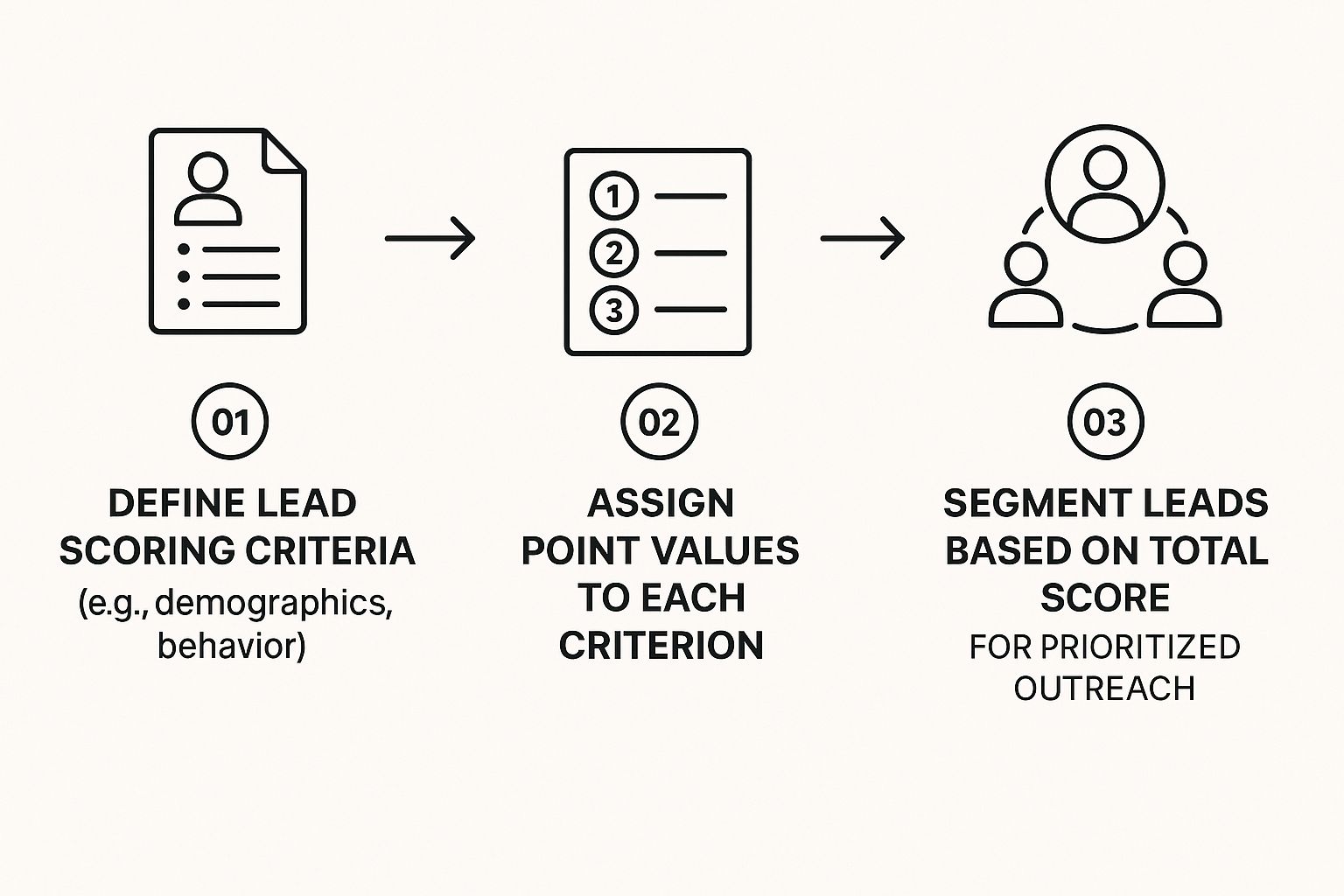Lead scoring is one of those concepts that sounds way more complicated than it is. At its core, it’s a ranking system that sales and marketing teams use to figure out who's actually interested in buying and who's just browsing.
You assign points to people based on who they are and what they do. It’s a beautifully simple way to cut through the noise and show your team exactly where to focus their energy.
What is Lead Scoring, Really? (And Why Should You Care?)

Think of your sales pipeline like a packed airport terminal. You've got all kinds of people milling about. Some are just killing time at the duty-free shops, others are grabbing a coffee, and a few are sprinting towards their gate, ticket in hand, ready for takeoff.
Without a system, your sales team is stuck guessing. They might waste hours talking to the window shoppers while the people ready to fly get away.
Lead scoring is that system. It's the big flight information board that tells you exactly which "passengers" are ready for their journey. By assigning points for specific actions and attributes, you create a clear, prioritized list of who to talk to right now.
The Real Goal of Scoring Leads
The main point here is to get your marketing and sales teams on the same page. It’s a classic problem: marketing generates a ton of leads, but sales complains they're all junk. Lead scoring fixes this.
Marketing brings people in the door, and the scoring system qualifies them. This ensures that sales only gets handed leads who are genuinely interested and a good fit for what you're selling. It's a methodical way to stop wasting everyone's time on dead ends.
"Lead scoring acts as a translator between marketing engagement and sales readiness. It quantifies interest, turning abstract digital behaviors into a concrete roadmap that tells your sales team exactly who to call next."
This isn't just about making life easier; it has a direct impact on the bottom line. The data backs this up, too. Companies that get lead scoring right often see a 77% increase in their lead generation ROI.
It works by blending what you know about them (explicit data like job titles) with what they do (implicit data like visiting your pricing page). If you're curious about the mechanics, Wikipedia's detailed overview offers a deeper dive into the methodology.
Let's break down the key components that make up a typical lead score. A good system looks at a mix of demographic, firmographic, and behavioral signals to paint a full picture of a lead's potential.
Key Components of a Lead Score
| Scoring Category | What It Measures | Example Data Points |
|---|---|---|
| Demographic | Individual characteristics of the person. | Job title, seniority level, department (e.g., Marketing vs. IT), years of experience. |
| Firmographic | Characteristics of their company. | Company size, industry, annual revenue, geographic location, technology they use. |
| Behavioral | Actions the lead takes with your brand. | Visited pricing page, downloaded an ebook, attended a webinar, opened an email, requested a demo. |
| Negative | Actions that signal a poor fit or low interest. | Unsubscribed from emails, visited the careers page, is a student, industry mismatch. |
By combining these elements, you move beyond guesswork and start making data-driven decisions about where to invest your sales team's precious time.
The Tangible Benefits of a Scoring System
Putting a lead scoring framework in place is about more than just efficiency—it's about working smarter. It brings a new level of intelligence to your entire sales process.
Here’s what you stand to gain:
- Massively Increased Sales Efficiency: Your sales reps stop chasing ghosts. They get to focus their talent on nurturing and closing high-scoring leads who have already demonstrated real interest.
- Better Conversion Rates: Timing is everything. By reaching out when a lead's score signals high intent, you dramatically boost your chances of making the sale.
- A True Partnership Between Marketing and Sales: Finally, a shared definition of a "qualified lead." This eliminates the friction and gets both teams pulling in the same direction.
- More Predictable Revenue: When you have a clear picture of your pipeline's quality, you can forecast sales with much greater accuracy. This makes strategic planning less of a guessing game.
The Mechanics of a Strong Lead Scoring Model

So, how does this all work in practice? To really get what lead scoring is, we need to pop the hood and look at the engine.
Think of a good lead scoring model like a detective piecing together a case. They need two types of evidence: the hard facts about a suspect (who they are, their background) and the clues from their recent behavior (where they’ve been, what they’ve touched).
In the sales world, we call these explicit scoring and implicit scoring. They work hand-in-hand to build a complete picture of a lead’s potential. One tells you who they are, the other tells you how interested they are. A solid model balances both to give you a reliable way to spot your best opportunities.
Explicit Scoring: What a Lead Tells You
Explicit scoring is all about the clear, factual information a lead gives you willingly. This is the "who they are" part of the puzzle—the demographic and company data that tells you if they fit your Ideal Customer Profile (ICP).
You usually collect this stuff through website forms when someone grabs an ebook, signs up for a webinar, or asks for a demo. It's direct, it's simple, and it's the foundation for figuring out if they're a good fit.
Here are some classic examples of explicit data points you might score:
- Job Title: A "VP of Sales" could be worth +15 points, while an "Intern" might only get +1. Seniority is a huge indicator of buying power.
- Industry: If you sell to SaaS companies, a lead from the tech industry could net +10 points. Someone from retail? Maybe 0.
- Company Size: If you're targeting enterprise clients, a company with 500+ employees is a big deal and might get +20 points, whereas a startup with 1-10 employees gets just +2.
- Geographic Location: Is your main market North America? A lead from the USA or Canada should score way higher than one from a region you don't even serve.
The screenshot above shows a basic scoring table where points are assigned to these kinds of attributes. This is your first filter, helping you separate the high-potential leads from the obvious non-starters right from the jump.
Implicit Scoring: What a Lead Does
While explicit data tells you about fit, implicit scoring uncovers interest. This is where you track a lead's "digital body language"—the actions they take that scream engagement and buying intent. This is the detective’s behavioral evidence.
Think about it: a lead who binges your product demo videos is showing way more interest than someone who just subscribed to your newsletter. Implicit scoring is how you capture that difference.
A lead's actions speak louder than their job title. Tracking their digital footprint gives you a real-time gauge of their interest, helping you understand their journey and intent far better than demographic data alone.
These behavioral signals are absolute gold for timing your outreach perfectly. You can learn more about turning these signals into action in our guide on how to prioritize sales leads, which is packed with practical strategies.
The Power of Negative Scoring
A truly smart lead scoring model doesn't just add points; it knows when to take them away. Negative scoring is a critical, often-overlooked tool for weeding out leads who look good on paper but are actually a poor fit or have gone cold.
This one simple trick keeps your sales team from chasing dead ends and ensures your pipeline stays clean and focused.
Here are some common triggers for docking points:
- Visiting the careers page: A classic sign they're looking for a job, not your product (-25 points).
- Using a student email address: They're probably doing research for a class, not making a purchase decision (-15 points).
- Long periods of inactivity: If a lead hasn't opened an email or visited your site in 90 days, their interest has clearly faded. Time to lower that score.
- Unsubscribing from your email list: This is the clearest signal of disinterest you can get (-50 points).
By blending positive scores for fit and interest with negative scores for disqualifying traits, you create a dynamic, three-dimensional view of every single lead. This balanced approach is what turns a simple points system into a powerful lead-generating machine.
How to Build Your First Lead Scoring Framework
Building a lead scoring framework from the ground up can sound like a huge undertaking, but it's really not. At its core, the process is about understanding your best customers and then turning what makes them great into a simple points system.
Think of it like creating a recipe for your ideal lead. You're just listing out the key "ingredients" (their traits) and the "cooking instructions" (their actions) that lead to a sale. This five-step process will help you build that recipe, giving you a practical model you can launch and tweak over time.
Step 1: Define Your Ideal Customer Profile
Before you can assign a single point, you have to know who you're scoring for. Your entire system hinges on having a crystal-clear picture of your Ideal Customer Profile (ICP). This isn't about one specific person, but a detailed description of the perfect company for your product.
If you don’t have a formal ICP written down, no problem. Just look at your top 10 or 20 happiest, most successful customers. What do they have in common? What industries are they in? How big are their companies? What specific problem were they trying to fix when they found you?
This simple exercise gives you the raw data you need. Without a solid ICP, your scoring is just guesswork, and you'll end up chasing the wrong leads.
Step 2: Identify Key Demographic and Firmographic Data
With your ICP defined, it's time to translate those characteristics into specific, scorable data points. This is where you pinpoint the key demographic info (about the person) and firmographic info (about their company) that screams "good fit."
Grab your sales team for this part. They're on the front lines and have a gut feeling for which traits correlate with a closed deal. Ask them things like, "Which job titles are the easiest to talk to?" or "Do we have better luck with companies of a certain size?"
Here are a few common attributes you'll want to assign points to:
- Job Title/Seniority: Are they a decision-maker (like a VP or Director) or someone who influences the decision?
- Industry: Is their company in one of your target industries?
- Company Size: Do they have the right number of employees or revenue to be a good fit?
- Geography: Is their company located in a region you actually serve?
Step 3: Map Out Critical User Behaviors
Okay, now let's shift from who they are to what they do. This is where behavioral scoring comes in. You're tracking how a lead engages with you online, which is a fantastic indicator of their interest and intent to buy.
Not all actions are equal, though. Someone downloading a general checklist isn't nearly as hot as someone who requests a demo. Your job is to assign point values that reflect this difference. A high-value action should get a high score. Simple.
This flow chart gives you a good visual of how the process works—from setting criteria to assigning values and finally, segmenting leads for your sales team.

As you can see, it's a logical progression: define, score, and then segment for a focused follow-up.
Step 4: Assign Point Values and Thresholds
Here’s where the magic happens. You'll assign a specific number of points to every attribute and behavior on your list. This whole concept has completely changed how sales and marketing teams work together, creating a clear, numeric scale where leads rack up points based on who they are and what they do. It helps companies sort leads into hot, warm, or cold buckets, which makes outreach so much more efficient. For a deeper dive, TechTarget offers more insights on how lead scoring works.
Here’s a quick and dirty example of what your points might look like:
| Attribute/Behavior | Description | Points |
|---|---|---|
| Job Title | VP or C-Suite | +20 |
| Industry | Target Industry (e.g., SaaS) | +15 |
| Behavior | Demo Request | +30 |
| Behavior | Pricing Page Visit | +10 |
| Behavior | Career Page Visit | -25 |
Once your points are set, you need to establish thresholds. These are the total scores that trigger an action from your team.
Your score thresholds are the bridge between marketing and sales. They define the exact moment a lead is qualified and interested enough to get a direct call or email.
A common setup uses these tiers:
- Marketing-Qualified Lead (MQL): A lead who hits a baseline score (say, 50 points) and is ready for more marketing nurture.
- Sales-Qualified Lead (SQL): A lead with a high score (like 100+ points) who needs an immediate follow-up from a sales rep.
Step 5: Launch and Continuously Improve
Your lead scoring framework isn't a "set it and forget it" project. Think of it as a living system that needs regular check-ups and tweaks. Launch your first version, but plan to circle back every quarter to see how it's performing.
Keep a close eye on the results. Are the leads that sales are closing the ones with the highest scores? Are any low-scoring leads surprising you and converting anyway? Use that real-world feedback to adjust your point values and thresholds. Over time, your model will get smarter and become an incredibly reliable predictor of your next big sale.
Common Lead Scoring Models and Examples

Let's get one thing straight: there's no single, "best" way to score leads. The right method for you is completely tied to your business model, how long your sales cycle is, and who you're selling to. A B2B software company has a totally different playbook than an e-commerce store, and their scoring models should reflect that reality.
The whole point is to pick a model that actually lines up with what you're trying to achieve. So, let's break down some of the most common approaches to help you find the perfect fit. Each one gives you a different angle for measuring a lead's potential.
Demographic and Firmographic Models
This is usually where everyone starts. It’s the most straightforward model because it focuses only on explicit data—the hard facts you already have about a person and their company. Think of it as your bouncer at the club, checking IDs to see who gets past the velvet rope.
This model is a lifesaver for businesses that have a crystal-clear Ideal Customer Profile (ICP). If you know you only sell to VPs of Marketing at SaaS companies with over 500 employees, this model cuts through the noise beautifully.
- Primary Focus: Who the lead is and where they work.
- Best For: Companies with a well-defined, narrow target market.
- Example: A cybersecurity firm might give top scores to a "CISO" (+25 points) at a "Financial Services" company (+20 points) with "1,000+ employees" (+15 points).
Behavioral Scoring Models
While demographics tell you if a lead is a good fit, their behavior tells you if they're actually interested. This model cares more about what a lead does than who they are on paper. It’s built on the simple idea that actions speak louder than job titles.
This approach is especially powerful if you have a longer sales cycle or rely on content to warm up prospects. A lead who has downloaded three whitepapers and attended a webinar is practically waving a flag that says "I'm interested!"—even if their title is just "Manager."
For instance, a marketing agency would score a lead much higher for visiting their "Case Studies" page (+15 points) than for simply being a "Marketing Manager" (+5 points). The model rewards active engagement.
Blended or Hybrid Scoring Models
For most B2B companies, this is the sweet spot. A blended model is exactly what it sounds like: it combines the "who they are" of demographic scoring with the "what they do" of behavioral scoring. This gives you the most complete, 3D picture of a lead.
A blended model ensures you're not just talking to the right people, but you're talking to them at the right time. It balances a lead's potential fit with their current level of interest for maximum accuracy.
This hybrid approach stops your sales team from chasing a high-ranking CEO who has shown zero interest, while also filtering out enthusiastic interns who will never have the budget to buy. There’s a reason it’s the most common model—it just works.
Let's look at an example for a B2B SaaS company:
- Hot Lead: A "VP of Sales" (+20 points) from a company with "200-500 employees" (+15 points) who just requested a demo (+30 points) and viewed the pricing page (+10 points). Total: 75 points. Get sales on the phone, now.
- Cold Lead: A "Marketing Intern" (+1 point) who downloaded a top-of-funnel ebook (+5 points). Total: 6 points. This lead needs nurturing, not a sales call.
Predictive Lead Scoring
Welcome to the next level. Predictive lead scoring uses machine learning and AI to sift through mountains of your historical data—from both won and lost deals. The AI then starts to identify the subtle patterns and correlations that a human would almost certainly miss.
Instead of you guessing that a "Director" is worth 15 points, the algorithm looks at your past successes and determines the exact value of that job title. The best part? It's always learning and refining its own logic, getting smarter and more accurate over time.
While it demands a lot more data and more advanced tools, predictive scoring takes the guesswork out of the equation. It's the most dynamic and potentially the most accurate model out there today.
Lead Scoring Model Comparison
To make things even clearer, let's put these models side-by-side. Seeing their core differences can help you decide which path makes the most sense for your team right now.
| Model Type | Primary Focus | Best For | Example |
|---|---|---|---|
| Demographic/Firmographic | Who the lead is (job title, industry, company size) | Businesses with a very specific Ideal Customer Profile (ICP). | +20 points for "Director" title in the "Tech" industry. |
| Behavioral | What the lead does (website visits, downloads, email opens) | Companies with a long sales cycle or strong content marketing. | +30 points for requesting a product demo. |
| Blended/Hybrid | A combination of demographic and behavioral data | Most B2B companies seeking a balanced, comprehensive view. | A "Manager" (+10) who also attended a webinar (+25). |
| Predictive | AI-driven analysis of historical conversion data | Data-rich companies wanting the highest accuracy and automation. | The algorithm determines that leads from a specific region who download a certain PDF convert at a 15% higher rate. |
Ultimately, you can start simple and grow from there. Many companies begin with a basic demographic model, add behavioral elements as they get more comfortable, and eventually explore predictive options once they have enough data.
Best Practices for Launching Your System
Look, building a brilliant lead scoring model is only half the battle. The real magic happens when you launch it thoughtfully. The build is the technical part, sure, but getting it to actually work for your team requires planning, getting everyone on the same page, and a promise to keep making it better.
Think of your new scoring system like a high-performance engine. You wouldn't just drop it into a car and hope for the best, right? You’d connect it properly, test it out, and show the driver how to handle it. It's the same idea here—a great launch ensures your system doesn't just run, but actually drives results.
Align Sales and Marketing from Day One
The single biggest reason lead scoring initiatives fail? A total disconnect between sales and marketing. If these two teams aren't reading from the same playbook, the whole system just falls apart. This can't be an afterthought; it has to be your foundation.
Get both teams in the same room (virtual or otherwise) when you're hashing out the scoring criteria. Marketing might think anyone who attends a webinar is a hot lead. But sales, from their experience on the front lines, knows that only the attendees who jump into the Q&A ever turn into actual customers. That kind of real-world insight is gold.
This collaborative spirit is the whole point of lead scoring. It’s a method designed to get sales and marketing laser-focused on the same high-value people by putting numbers on key actions and traits. When it's done right, companies see a major lift in conversions because everyone finally agrees on what a "good lead" actually looks like. You can find more on this at blog.thomasnet.com's post on lead scoring efficiency.
When you build the model together, you create a shared sense of ownership and, most importantly, a single definition of a lead worth chasing.
Integrate and Automate Your Workflow
Your lead scoring system should make everyone's life easier, not add another complicated step. This means it absolutely must plug into the tools you already use, especially your CRM and marketing automation platform. The goal is a completely smooth, hands-off handoff process.
- CRM Integration: Scores need to be right there on the lead's record in the CRM. Sales reps shouldn't have to dig for this info. It needs to be front and center, telling them who to call next at a single glance.
- Automated Alerts: Set up instant notifications for your sales team. The second a lead crosses that "Sales-Qualified Lead" (SQL) threshold, the right rep should get a ping via email or Slack.
- Task Creation: Take it a step further. Automatically create a "Follow Up" task in the CRM the moment a lead becomes an SQL. This kills any manual work and makes sure no hot lead ever slips through the cracks.
A tightly integrated system gets rid of the friction. It turns a simple score into an action—a trigger that powers your entire sales engine with speed and consistency.
Establish a Regular Review Cadence
Lead scoring is not a "set it and forget it" kind of deal. Your market changes, your product evolves, and your customers' behaviors shift. Your scoring model has to keep up. A signal that pointed to a hot lead today might be totally meaningless in six months.
Put a formal review on the calendar at least once a quarter. This meeting needs to have the key players from both sales and marketing in the room, ready to dig into the data.
You should be hunting for answers to these questions:
- Are the leads with the highest scores actually turning into customers?
- Are we seeing any low-scoring leads convert out of nowhere?
- What's the sales team saying about the quality of the SQLs they're getting?
- Do we need to tweak the point values for certain actions or demographics?
This constant feedback loop is what keeps your model sharp over time. For a deeper dive, check out our guide on essential lead scoring best practices. When you treat your system like a living, breathing tool, you ensure it stays an accurate predictor of who's ready to buy.
Got Questions About Lead Scoring? We've Got Answers.
Even with a solid plan, you're bound to have questions once you start putting lead scoring into practice. It's totally normal. Let's tackle some of the most common ones that pop up, so you can get your system running smoothly.
How Often Should I Update My Lead Scoring Model?
Your lead scoring model shouldn't be a "set it and forget it" kind of thing. Think of it more like a living, breathing part of your sales process.
A good starting point is to review its performance every quarter and plan for a proper tune-up at least twice a year. The whole idea is to make sure your scores still accurately point to who's actually ready to buy.
You’ll also want to revisit your model any time your business makes a big move. Launching a new product? Entering a new market? Seeing a sudden shift in lead quality? Those are all perfect times for a review. Keep an eye on which leads actually turn into customers—that's the data you'll use to keep your model sharp.
Think of your model like a financial portfolio; it needs regular rebalancing to perform optimally. Sticking to a "set it and forget it" approach is a surefire way to let your model's accuracy decay over time.
This isn't busywork. It's proactive maintenance that ensures your sales team is always focused on the best possible leads.
What Is the Difference Between Lead Scoring and Grading?
This one trips people up all the time. While "scoring" and "grading" sound similar and work together, they measure two very different—but equally important—things. Getting the distinction is key to seeing the full picture of a lead's potential.
- Lead Scoring is all about interest. It answers the question, "How interested is this person in us?" This score is based on implicit behavioral data—things they do, like visiting your pricing page, downloading a whitepaper, or clicking on your emails.
- Lead Grading is all about fit. It answers the question, "How interested are we in this person?" This grade is based on explicit attribute data—facts about them, like their company size, industry, or job title.
The dream lead? Someone with both a high score (they're super engaged) and a high grade (they're a perfect fit for your business). This is a core concept in the bigger picture of sales readiness, and you can dive deeper into how it all works in our guide on what is lead qualification. When you nail both, you create a prioritization system that’s practically unstoppable.
Can a Small Business Benefit from Lead Scoring?
Absolutely. In fact, you could argue small businesses need it more.
While lead scoring might sound like something only big corporations with massive sales teams do, it's a game-changer for smaller businesses where every minute and every lead counts. You don't have the luxury of wasting time.
By setting up even a basic scoring system, a small team can instantly see which opportunities are most likely to close. It helps you prioritize follow-ups so promising leads don't slip through the cracks while you're chasing dead ends.
Plus, you don't need a team of data scientists to get started. Many modern CRM and marketing platforms have user-friendly lead scoring features built right in. For a small business, it’s one of the most effective ways to boost efficiency and punch above your weight.
Ready to turn these insights into action? Salesloop.io provides the tools you need to identify high-intent leads and automate your outreach with precision. Stop guessing and start engaging the prospects who are ready to buy. Explore how Salesloop.io can scale your sales efforts today!





